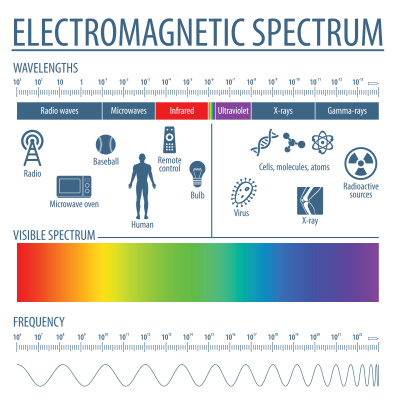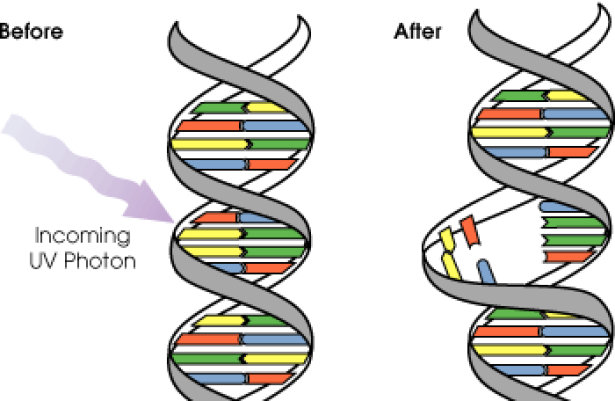What is UV-C?
UV-C radiation generated by high-energy UV-C lamps moves at a wavelength range between 200 – 280nm, which is very versatile and can be used for disinfecting water, destroying harmful micro-organisms in other liquids, on surfaces, on food products and in air. With UV-C technology it is possible to destroy more than 99.9% of all pathogens within seconds, without addition of chemicals, without harmful side effects, and an inexpensive solution that is highly efficient and reliable.

How does UV-C disinfection work?
UV-C, a high-energy form of ultraviolet radiation, is absorbed by the DNA and RNA of biological organisms. This stimulates the formation of thymine dimers which, in large numbers, disrupt the replication process of cells and leaves microorganisms (such as bacteria and fungi) and viruses unable to reproduce or cause harm. UV-C is also absorbed by proteins. This causes cell walls to rupture and can lead to the death of organisms that protect their DNA with thick cells. UV-C is often referred to as germicidal radiation because of this ability to inactivate microorganisms.

Can UV-C kill coronavirus?
Yes. In fact, the COVID-19 pathogen is particularly vulnerable to UV-C irradiation since it does not form colonies and is spread through tiny droplets of body fluid (aerosols). UV-C light penetrates these aerosols, destroying the DNA and RNA of the SARS-CoV-2 virus.
Can UV-C purify air?
Viruses like influenza and SARS-CoV-2, as well as other germs and microorganisms, are suspended in tiny droplets of human bodily fluid, called aerosols. These aerosols are dispersed into the air, spreading infectious diseases from one person to another through breathing and contact with the skin. Bigger droplets fall to ground – typically within 1,5m but aerosols stay airborne for very long times. UV-C air purification works by drawing contaminated air inside a closed box and exposing it to contained UV-C radiation, neutralizing up to 99.9% of microorganisms and viruses.
Can UV-C sterilize water?
Germs in water can also be treated with UV-C in the same way as germs in air. This technology has been used for many years and is particularly popular for drinking water because, unlike chlorine, for example, it leaves no taste behind. As with air, the irradiation is carried out in closed reaction chambers.
Can UV-C disinfect surfaces?
UV-C light is an effective method for destroying viruses, bacteria, germs and other microorganisms on surfaces. Its efficacy is determined by the distance from the source, the amount of radiation, and the duration of exposure. Since UV-C requires direct exposure, it may be necessary to move the light source to reach shadowed areas when disinfecting surfaces that are not flat and smooth. Surface disinfection products with open light fixtures must be used with caution, taking care to avoid exposure to humans, animals and plants at all times.
How safe are closed and open UV-C products?
OSRAM products with closed (or hidden) fixtures are suitable for use around people, pets, and plants as they release virtually no UV-C radiation. The slight blue glow that is sometimes visible is not UV-C but rather a small amount of visible light generated by the low-pressure discharge. This blue light is not harmful and merely indicates activity.
OSRAM open light fixtures products must be used in accordance with strict safety guidelines, which vary by fixture type. The fixtures emitting UV-C radiation throughout a room should never be turned on while people are present.
Can UV-C light go through glass?
In most cases, glass walls and windows block UV-C, providing adequate protection for people. However, companies must test for light leakage when installing fixtures.
How can I ensure that UV-C does not harm me?
The number of UV-C products on the market has risen sharply in the wake of the global pandemic. Unfortunately, many of these products are unregulated, ineffective and potentially dangerous due to low quality manufacturing. For your safety, always purchase from a well-known and trusted manufacturer. Closed fixture products should be encapsulated with no emission of UV-C radiation or ozone (OSRAM products are ozone free) and training must be provided for open fixture products, especially those for surface disinfection.
How do I know that the product really inactivates germs?
While there are product safety regulations in Europe, manufacturers are not yet required to prove that their product is effective. To avoid fake and defective products, opt for products from well-known manufacturers or look for proof of efficacy from independent test institutes for the product in question.
Who is monitoring and enforcing product safety for UV-C?
YManufacturers are responsible for monitoring the safety of their products in cooperation with independent test laboratories (notified body, e.g. VDE, SGS). All UV-C products produced by OSRAM meet the European safety standards.
Do UV-C lights give off an odour?
OZONE generated by UV-C has a particular smell. However, all OSRAM products are tested and verified 100% OZONE-free.Small residuals on the inner surfaces decompose and burn up, giving off a smell. This is a common occurrence when using appliances that heat up for the first time, such toasters. The odour only lasts few a few minutes and can be removed with ventilation from an open window.
How effective the UV-C light in Water Purifiers at home?
UV-C Water Purifiers treat micro-biologically unsafe water with germicidal ultraviolet light. The UV-C radiation changes DNA structure of microorganisms, either killing them or rendering them unable to breed. UV-C disinfection tubes deactivates 99.99% of living organisms in the water.
How does UV-C work in Water Purifiers?
UV-C radiation wavelength range is between 200 nm and 280 nm. Purification effect is obtained with wavelengths below 320 nm, with maximum effectiveness at 260 nm. OSRAM UV-C germicidal lamps emit light at 254 nm. This globally accredited purification technology is widely utilized in Water Purifiers.
Can we consider all Blue Light tubes as UV-C tubes?
The Blue wavelength is the most imminent one to the UV light on the light spectrum, but it doesn’t carry the disinfection characteristic of UV-C light. Please be careful of low cost fake Blue light tubes. OSRAM is one of the few global brands offering UV-C tubes since decades.
When should you replace the UV-C tube inside your Water Purifier?
UV-C tubes don’t burn out, they solarize, which means the light wave intensity reduces over time and it no longer effectively neutralizes bacteria, virus etc. So, it is suggested to replace the UV-C tube after one year.
How does UV-C work in HVAC/ AHU or AC Ducts?
The UV-C wavelength can kill 99 percent or more of all microorganisms living on HVAC air ducts and evaporator coils, depending on UV-C intensity, length of exposure, UV-lamp placement, and lamp life cycle.
The UV-C lamps using more or higher output lamps will increase the total dose that is, the microwatt seconds per square centimeter (µW s/cm²). Lamps with 360 degree irradiation allow more UV-C energy to saturate a plenum, increasing UV-C fluence.
What are the means to apply UV-C in HVAC/ AHU or AC Ducts?
UV-C light in HVAC/AHU or AC Ducts can be applied in 3 different ways: upper-room/air systems, HVAC air-stream disinfection, and HVAC coil/surface irradiation.
